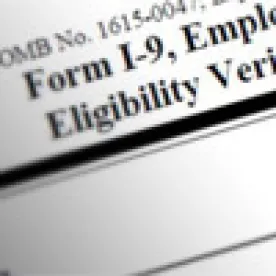The Department of Homeland Security’s COVID-19 flexibility regarding the physical presence requirements for I-9 inspection ends on July 19, 2020, for companies that are still operating 100-percent remotely. Unless further extended, the three-day rule to review the original documents in person will kick in on that date. But that three-day clock may start ticking sooner if your company is starting to return to the worksite before July 19, 2020.
Since instituting flexibility, Immigration and Customs Enforcement (ICE) has maintained that if there are any employees physically present at the worksite, I-9 flexibility would not be an available option. However, without offering any specific guidance, ICE also said that it would evaluate this on a case-by-case basis.
Given the COVID-19 national emergency, employers have had to try to determine what would be reasonable in that light.
-
If only maintenance or security staff are on site, is flexibility available?
-
If some employees have been on site because they are essential workers, but the newly hired employees are working remotely, is flexibility available?
-
If there is no human resources staff on site and they normally conduct Form I-9 verifications, is flexibility available?
-
If the new employee had no access to a designated authorized representative, is flexibility available?
-
And now, as the flexibility ends, if employees are just starting to return on a staggered basis, is flexibility available or does the three-day rule kick in as soon as any employees return?
Arguably, considering the COVID-19 risk-benefit analysis, flexibility should be available in all these circumstances, but the determinations that ICE officers will make are uncertain until ICE starts auditing again. ICE may very well begin more audits as worksites reopen. Accordingly, it is important to start reinstituting “normal” I-9 process as soon as possible to demonstrate good faith efforts. These include the following:
-
Ensure an accurate list of all employees whose I-9 verification or reverification was conducted remotely.
-
As part of the return-to-work communications, notify all those employees to bring their original documents to the appropriate staff member within three business days of their return to the office.
-
Be careful not to discriminate or engage in document abuse by requesting specific documents.
-
Ensure the staff has been trained on how to accurately annotate the Forms I-9.
-
Depending upon the number of employees who participated in an electronic I-9 inspection, provide a specific time and place for the inspection of their original documents.
-
If there is a staggered return to work, it is best practice to have any new employees come to the office for an in-person review of their employment verification documents within three business days of their first day of work even if they will be working remotely initially.
-
The same would apply to employees whose initial verification or reverification was done remotely even if they are not yet returning to the worksite.
-
Alternatively, designate an authorized representative to act on the company’s behalf to review documents in person within three business days of the reopening of the worksite. ICE has made clear that any individual can be appointed a designated agent, but the employer will remain liable for any mistakes the agent might make. Therefore, choose someone reliable who is not likely to be biased in favor of the employee, i.e., a close relative or friend.
-
Create a “return to work” I-9 policy that describes what was done and when. This policy will be a defense against an ICE claim that the company could have completed physical inspections sooner or faster than it did. A good offense is your best defense!





 />i
/>i

